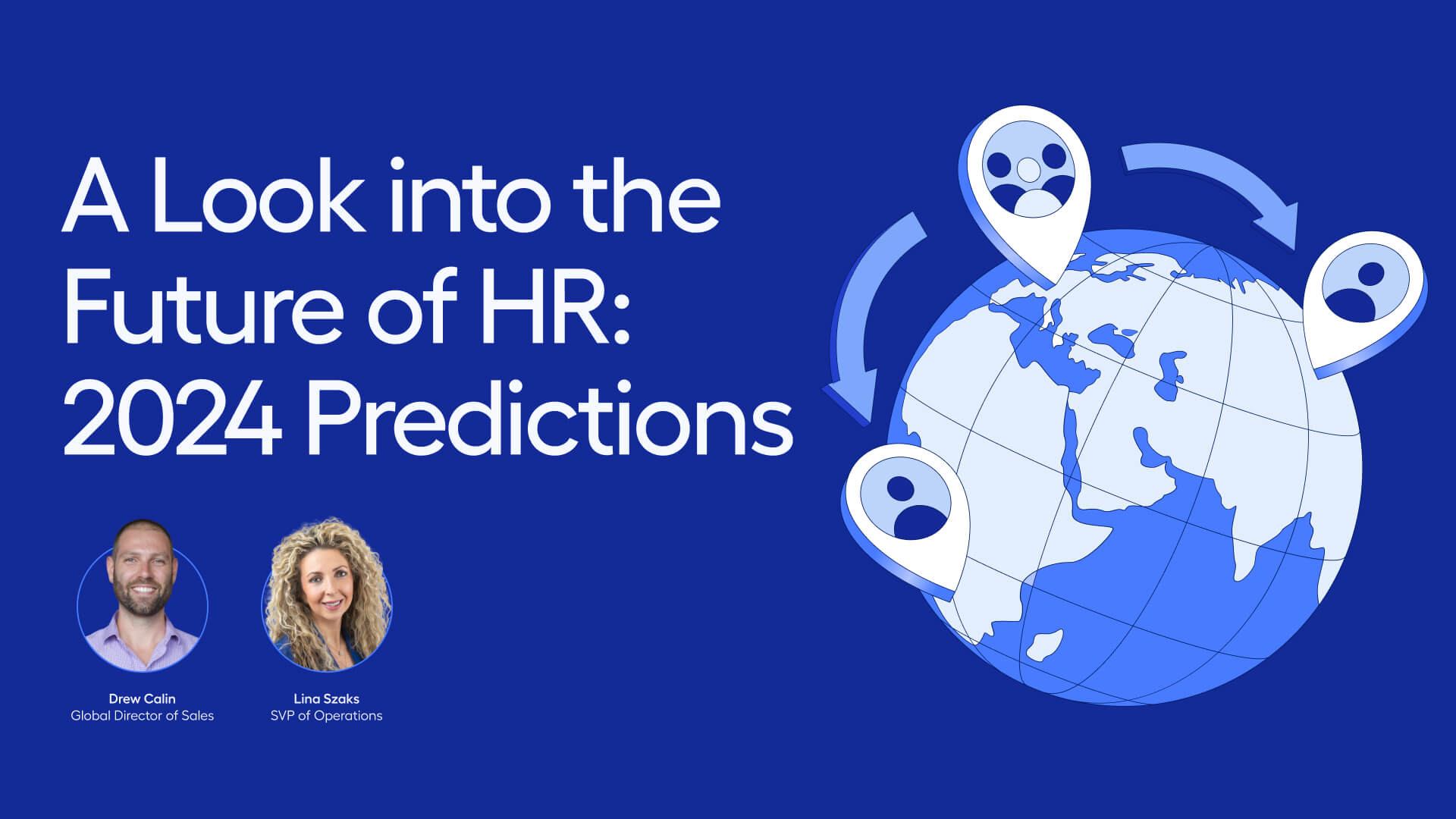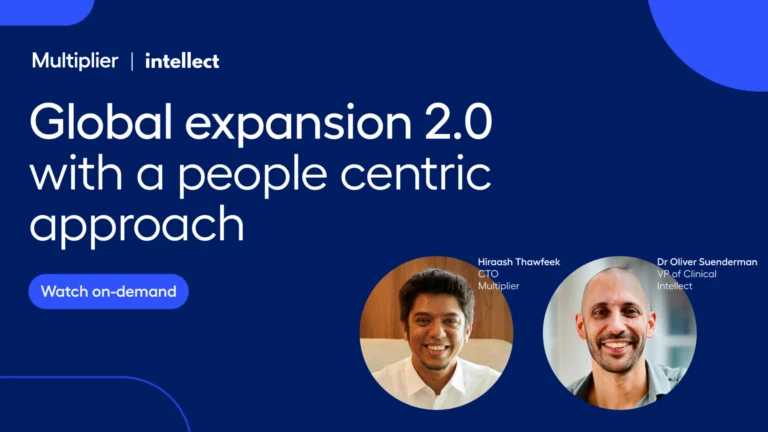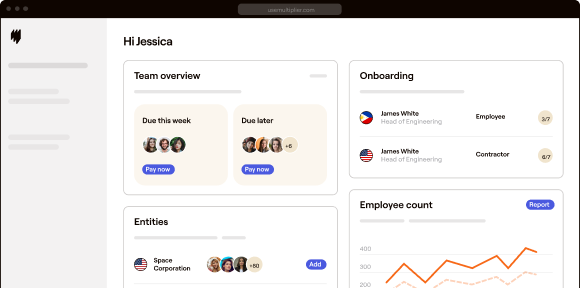The business world has changed beyond recognition in the past few years, with employers facing a dizzying array of new challenges such as financial uncertainty, a skills shortage, and the rise of AI.
Feeling overwhelmed? You’re not alone. We’ve put together this State of Work report, uncovering fresh insights from experts and survey polls to compile a list of HR predictions for the world of work in 2024, to help you out, as you may have seen. But we went a bit further to add even more context to this report.
Recently, our Director of Sales, Drew Calin, and SVP of Operations, Lina Szaks, appeared on LinkedIn Live to give a walkthrough of some of the report’s key findings—and their recommendations on what courses of action business leaders should take away.
Let’s dive into what they had to say about the future of HR.
Work-life integration
The discussion started with perhaps the single biggest change in how we work over the last few years: remote and hybrid working.
“The direct result of how we came to this is, honestly, COVID,” said Lina. “A few years ago, I was on airplanes going from city to city, service center to service center, leading global operation teams. When COVID hit, I was stuck in an unfinished basement with my kids e-learning, my husband at home, a dog, and a nanny. And that was quite the shock.
“But today, I wouldn’t trade it. I absolutely love the flexibility. I love the distributed workforce capability. I love to support clients with a distributed workforce, and I love to benefit from it myself.”
This phenomenon has led to a reassessment of how professionals want to balance their work and home lives and a move away from simple, siloed work-life balance to true work-life integration.
“Employees are really reevaluating their health, their hustle, the work-life balance, and how they want to implement that into their livelihood—especially now that we know that we can do distributed, global work successfully,” said Lina.
However, one of our report’s more surprising findings was that 76% of employees are experiencing burnout at work today—often due to them failing to get this balance correct.
“I personally have struggled with work-life integration,” Drew explained. “I found myself working excessive hours and working on weekends. It’s too easy. My laptop is just there. And now we work asynchronously; we’re used to this mode where there’s just this revolving wheel of constant connectivity.
“Employers have struggled to understand that while their employee base is saying ‘we want to be remote,’ they’re also battling many of the realities of what that means for themselves.”
How businesses can help
Rather than wash their hands of the responsibility, companies need to be proactive about helping their employees get the balance correct.
“For the employer, I believe it starts with understanding that this is a business issue,” said Drew. “This is not just an HR function—every single business leader needs to be concerned with this because it directly impacts results. Happy employees will make happy customers; unhappy employees will result in unhappy customers.
“Once we understand the need to diagnose the well-being of our employee base, we have to ask the right questions. We have to take time now to connect with people at a human level. That requires humility, and that requires a lot of vulnerability. For instance, we should run skippable sessions to understand how individuals feel.”
Of course, that nurturing instinct does not necessarily come naturally to businesses. “Companies don’t like talking about feelings,” Drew explained. “They think that’s not a word we should discuss in the workplace. But I think that option is gone. I think companies that are unwilling to ask people how they feel will find themselves in a very difficult position because the world is requiring that right now.”
It’s also a question of leading by example. If business leaders can model work-life integration, employees will be encouraged to adopt healthier working practices. “We can’t have executives who work around the clock, who live unhealthy lives, talking to employees about work-life integration and mental well-being,” Drew explained.
“An example: our CEO Sagar talks a lot about the benefits of exercise and what that means for him. As for myself, I don’t work on the weekend too much. But sometimes I have to. And I don’t need people to receive those messages, whether it’s a Slack message, a WhatsApp message, an SMS, or an email, off hours. So I schedule send instead. We need to protect our teams, and we need to lead by example.
The rise of internal mobility
Another of our report’s headline findings was the importance of internal mobility in 2024. Rather than bringing in outsiders to fill roles, businesses will increasingly promote from within.
“86% of companies expect their turnover rates to remain high and above target until 2024,” Drew explained. “But 24% of companies worldwide have no strategy to facilitate internal promotion.”
“I’ve had the opportunity to work at startups, midsize businesses, and enterprise companies, and this topic comes up regardless of the organization’s size,” Lina confirmed. “It’s not always about being promoted to another role, but sometimes cross-functional or lateral movement. Identifying workers’ strengths and putting them in the right role so they can shine based on them is so powerful for an organization.”
The issue is becoming more relevant owing to high attrition rates and a global talent shortage. “The response should be to recognize internal talent, reconfigure them, make them feel valued, and retain them,” said Lina.
It can be hard, however, to put in place processes capable of recognizing talent and identifying the best places for it to thrive. Drew recommends starting with documentation.
“Itemize what a process looks like for people to move, whether vertically or horizontally, as well as the skills development required and what timelines people who deserve those opportunities should expect.”
That’s not to say that companies in 2024 will exclusively hire from within. “A fallacy that I’ve seen through a great part of my career is that we have to adopt one strategy or the other,” said Drew. “And that is an exceptional fallacy we must squash as business leaders. Because the truth is, we should be doing both—promoting and hiring externally where we need to.”
Back to the office?
The final area of our report Drew and Lina pulled out was the return to office phenomenon. In recent times, even companies seen as the vanguard of remote working, such as Zoom, have ordered their employees to go hybrid.
“I’m a firm believer in the power of distributed teams,” Drew explained. “That’s what we do here at Multiplier, and that’s what our customers are building. The benefits of building distributed teams are material—access to markets, access to talent, and access to cost efficiencies. These are things that are unquestionable about the benefit of building distributed workforces.
“That said, I don’t believe you go fully in-office or fully-distributed. There are situations in which an office environment makes sense. Hybrid offices are increasingly common amongst businesses in the States and internationally. In fact, Gartner predicts that 39% of knowledge workers will be in a hybrid arrangement by the end of this year.”
Multiplier itself is embracing the power of hybrid working. “We have opened an office now in Asia, and we are opening our first office here in the States in New York,” said Drew. “But we’re still a distributed company. A lot of our customers have the same mix of offices and a mix of distributed teams.
“To neglect that is a huge mistake. 98% of knowledge workers today want to be in a remote environment. Just mandate that they go to an office full-time, and there will be consequences, and you’ll suffer as a business.”
2024 Takeaways
In short, to succeed next year, companies need to reduce costs, optimize operations, retain existing employees, and find new talent—no easy task.
“In 2024, businesses must attain a high level of productivity and collaboration while ensuring the needs of their employees are met,” said Lina. “It’s really an employee’s market, and it has been for the last couple of years, which is 100% different from how we’ve seen it before. HR leaders will have to play an important role in driving initiatives and keeping up with retention and engagement rates.”
Those are just a sample of the insights served up—if you’re interested in hearing everything they had to say, head to the recording and have a watch!
Access game-changing global talent with Multiplier
We’re still in the early stages of our LinkedIn Live adventure, so stay tuned for future events we plan on hosting on the platform. While you wait, make sure to check out our State of Work report, which contains a huge amount of further insights into the year ahead.
Multiplier is here to help businesses boost their productivity with global talent, so why not talk to our experts and book a demo today?








